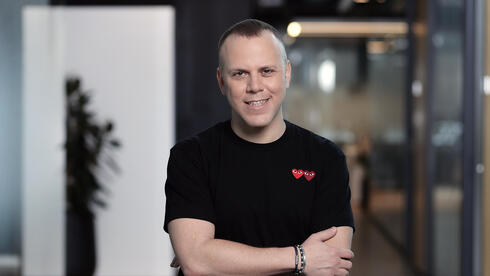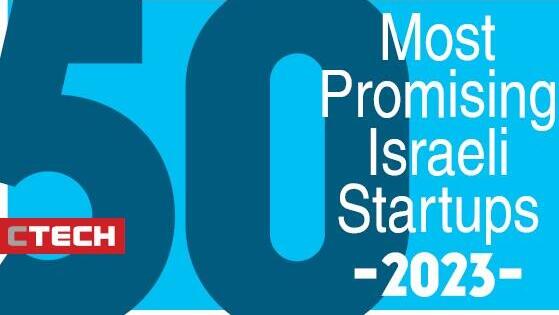
“We want to be in every clinic”: The Israeli startup out to change early disease detection
Backed by Google, the EU, and the IIA, NaNose Medical is pioneering non-invasive, breath-based diagnostics to close the gap in early detection of liver and lung cancer. As it approaches its Series A, co-founder and COO Ilay Marom says the Israeli startup is already eyeing real-world deployment and commercialization.
“Lung cancer and liver cancer are in the top three deadliest cancers in the world, simply because we catch it way too late,” said Ilay Marom, the co-founder and Chief Operating Officer at NaNose Medical.
Founded around five and a half years ago, NaNose Medical is working to change that reality. Launched “with the purpose of revolutionizing screening tests and early diagnosis,” Marom explained in conversation with CTech, the Israeli startup is pioneering non-invasive diagnostics based on breath biomarkers. It’s technology that holds particular significance for the early detection and future treatment of liver disease and lung cancer.
“Everybody knows early detection saves lives,” he continued. “Everybody knows about mammograms for breast cancer or colonoscopy for gastric cancer, but for several conditions like lung cancer and liver cancer, there's no equivalent test.”
The technology behind NaNose Medical comes from over a decade of research at Israel’s Technion Institute. “The inventor, Professor Hossam Haick, who is a partner in our company, approached the co-founders, and then we started this company.”
Marom says his personal involvement stems from a desire “to be involved with an impactful company that uses deep tech in order to help the world.”
Today, the startup employs 14 people, led by CEO Orit Marom-Albeck, and is focused on commercializing its breath-based diagnostic system, which bypasses traditional diagnostic tools that Marom describes as outdated.
“The way to screen patients today uses very old and non-advanced systems like blood pressure and ECG. These kinds of machines have been around for 30, 40, 50 years,” he said.
To date, NaNose has raised $10.5 million: $6.5 million in equity and roughly $4 million in non-dilutive grants, including funding from the EU (via Horizon Europe and EIC), the Israeli Innovation Authority, and Google.
However, like many startups, NaNose hit a roadblock in late 2023. While on an international roadshow, the team’s fundraising efforts were abruptly halted following Hamas’ October 7 attack on Israel and the subsequent war.
“We received an email that I will never forget,” Marom recalled.
“That due to ‘geographical strategy changes to policies’ they're stepping down. So we found ourselves really in a very tough spot.”
The Israel Innovation Authority stepped in with emergency support, followed by Google, which not only matched the grant but provided hands-on support, including software and AI cloud credits.
“They were extremely helpful,” said Marom.
Related articles:
- "Running a startup is like going to war—you need teammates who don’t give up when things get hard"
- Innovation Authority selects two new Deep Tech incubators to focus on energy, infrastructure, and medical tech
- The end of missed diagnoses? How AI is detecting breast cancer cases that physicians overlook
One of the key focuses at NaNose is targeting the diagnostic blind spots surrounding MASLD (Metabolic Dysfunction-Associated Steatotic Liver Disease). The condition affects roughly 40% of the global population and is often a precursor to more severe conditions like cardiovascular disease, type 2 diabetes, chronic kidney disease, and liver cancer.
MASLD alone represents a $103 billion burden on the U.S. healthcare system. “And yet there is no available screening tool for MASLD,” Marom continued. “We're looking to detect MASLD at advanced stages: the stage that needs immediate treatment in order to overcome these other comorbidities.
“Our vision is that our device will be in every physician's office, every clinic… to get immediate results of the risk of progressing or having an advanced stage of MASLD, which is the leading cause of liver cancer.”
The company’s technology is equally relevant for the early detection of lung cancer. Marom noted the inadequacies of today’s standard (CT scans), which remain inaccessible to many due to restrictive pre-screening criteria that exclude a large share of high-risk individuals.
“The pre-screening process today is being asked if you're over 50 years old and smoke cigarettes. If you're not over 50, and don’t smoke cigarettes, you’re not eligible for the post-screening process.”
This approach, he argued, ignores major risk factors like air pollution, and often delays detection until it's too late. Or as he puts it: “No symptoms, no screening.”
“Our vision is that we'll be able to capture early stage patients within primary care in order to refer them for the right test to proceed with the outpatient journey,” Marom continued.
The tech itself is based on a unique approach to mass spectrometry, which Marom says is inspired by the human olfactory system. This differentiates it from most competitor methods that rely on GC-MS (Gas Chromatography–Mass Spectrometry) machines, which are bulky, expensive, and require trained operators. As Marom commented on these methods: “The business model just doesn't make any sense”.
NaNose’s most direct competitor is the well-funded UK company Owlstone Medical. But Marom believes Nanose’s olfactory-inspired model gives them a weighty advantage in the market when it comes to real-world application and commercial viability.
“We took a very unique approach,” he explained. “Instead of analyzing each individual molecule, we analyze the pattern as a whole.”
He uses the analogy of cinnamon to illustrate the difference:
“Cinnamon is composed of different molecules, and when we smell it, unlike a GC-MS machine, we don't recognize each molecule or its concentration. Rather, our olfactory system interacts with those molecules. Then, the nerve system generates an electric signal to our brain [and] our brain processes it.
“When we ask the person next to us ‘What is the smell?’ and they tell us, ‘It’s cinnamon’ [then] for the rest of our lives, we know that the electric signal that was generated is correlated to cinnamon without having to know what the exact molecules and concentration are. This is exactly what we're trying to do.”
By training its AI on hundreds of breath samples from both healthy patients and those with disease, NaNose’s technology similarly learns to correlate electrical signal patterns with specific illnesses, without needing to pinpoint exact biomarker concentrations.
It’s a method Marom sees as “a very accessible, cost-effective screening tool,” and thus one that can viably penetrate the primary care market. By doing so, he said, “we can actually see what the patient's risks are for having lung cancer or liver cancer, and enhance the patient journey, and patient outcomes”.
Now, as the company gears toward commercialization, Marom credits his naval training, first as an officer on a missile ship and later as a team leader at the Naval Academy, followed by academic studies at Northwestern University, for giving him the operational discipline and managerial know-how to bring a solid startup product to market, even amid fierce competition and global market uncertainty.
Management and “the business side,” Marom concluded, “is crucial.”
“As promising as technology can be, and life-saving, sometimes it's not enough to bring it to the market if it doesn't bring actual financial value.”
For NaNose, as it prepares for its Series A, the next step will be proving its technology can deliver both.















